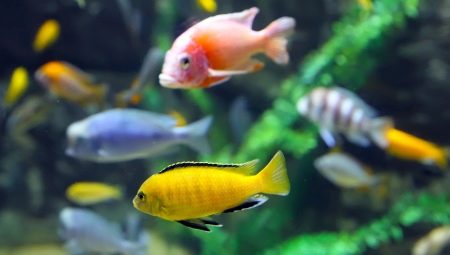Cichlids are quite aggressive in nature, but extremely beautiful, bright colors and spectacular appearance more than compensate for this drawback. Perhaps that is why these fish have gained popularity among aquarists around the world.
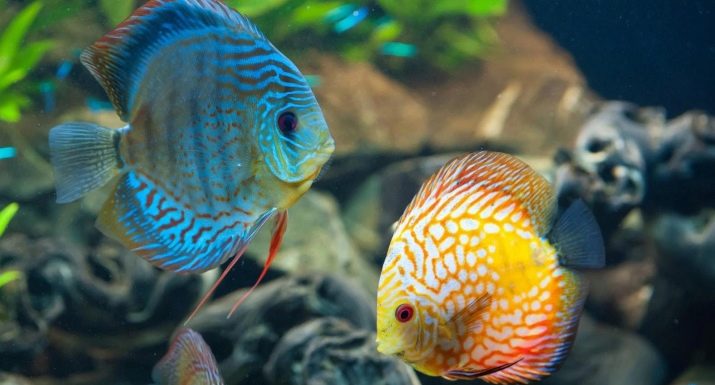
Family Features
Cichlids belong to a large family of cichlids. They are so diverse that not all species of these fish are described. Females are characterized by smaller sizes than males. The shape and length of the body of the fish depends on the species, as well as color options. The body length of members of the family can vary from 2 to 100 cm.
The life expectancy of cichlids on average reaches 10 years, although under appropriate conditions and care they are quite capable of living up to 20 years.
Cichlids are found in reservoirs and rivers in Africa, South America, Asia and belong mainly to endemic species. African cichlids are divided into two types:
- mbuna - eating plant foods;
- utaka - predatory species.
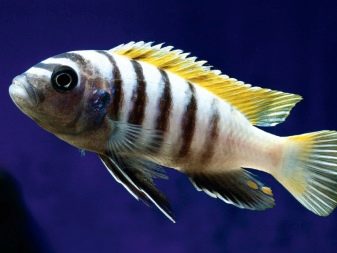
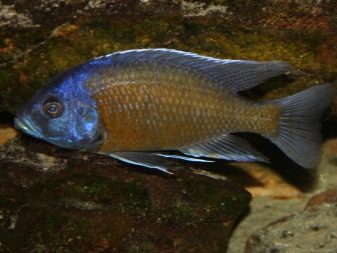
Cichlids are distinguished by an extremely aggressive nature, both to representatives of other species and to relatives. Males zealously guard their territory and help females raise offspring. Aquarium cichlids are quite capable of remembering the face of the owner. When approaching, they swim to the glass, they can even take food from their hands.
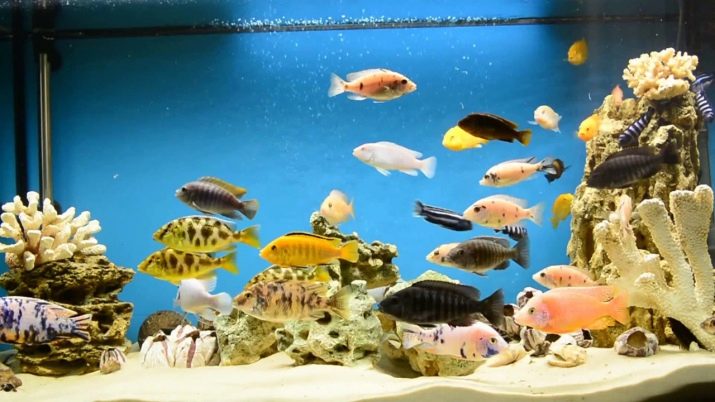
African species
Most of the representatives of cichlids reside on the African continent. The main habitats of these fish are one of the largest lakes in the world - Malawi, Tanganyika, Victoria, as well as other less well-known, except for lake species, there are river ones.The appearance of African cichlids is very diverse.
Most have an elongated, slightly flattened body. Fins in males are long, with sharp edges, and in females are more rounded.
Some species have a growth on the head or a slightly elongated mouth.
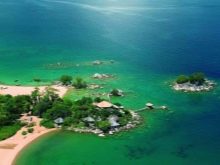
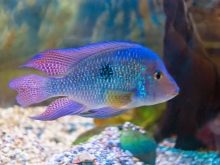

Most species have a spectacular, vibrant color, which helps to distinguish relatives among representatives of other species.
- Pelvicachromis pulcher or cichlid parrot has an elongated, slightly flattened body of yellow-brown color with a scarlet speck on the belly and small bright points on the fins. When excited or during spawning, the color becomes more saturated. Parrots grow relatively small, males - about 10 cm, and females - up to 7 cm. Average life expectancy is about 5 years. It has a rather peaceful character.
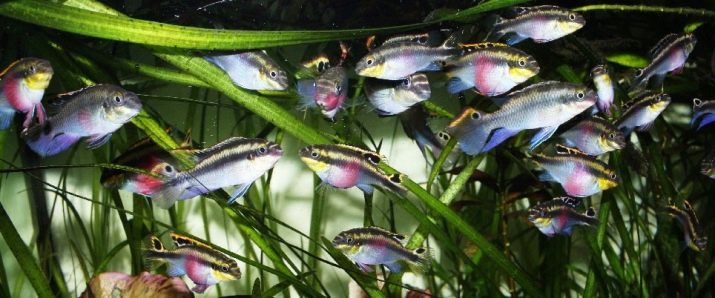
- Hemichromis Golden - An inhabitant of reservoirs and rivers in western Africa. The body of the fish is elongated and flattened on its sides, the head with a high forehead and thick lips. Color yellow-green, belly yellowish or faint red. There are 5 dark spots on the sides and gills. During spawning, the color of the fish becomes a golden tone, and the abdomen turns red. On average they live up to 10 years, the maximum length becomes 15 cm.
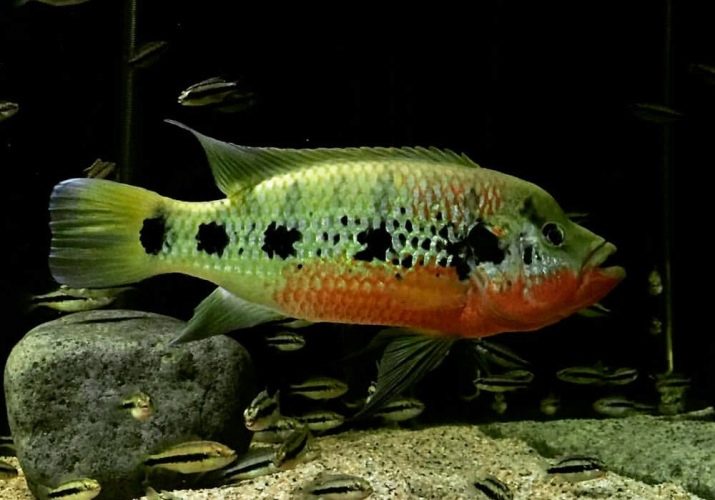
- Hemichromis red description similar to the previous representative of cichlids, but different in color. The fish has a bright red body with numerous dots of bluish tone, they are even on the fins. Males stand out a little larger, and as they grow older they have a growth on the head. Females have a lighter color and fewer spots. On average, grow up to 10 cm.

- Haplochromis cornflower - inhabitant of lake Malawi. It differs in an unusual blue color. The lower fin of the fish has a yellowish color, the dorsal fin is different in length, and on it, like on the tail, there are several small yellow spots. Adult individuals reach 20 cm, both males and females.
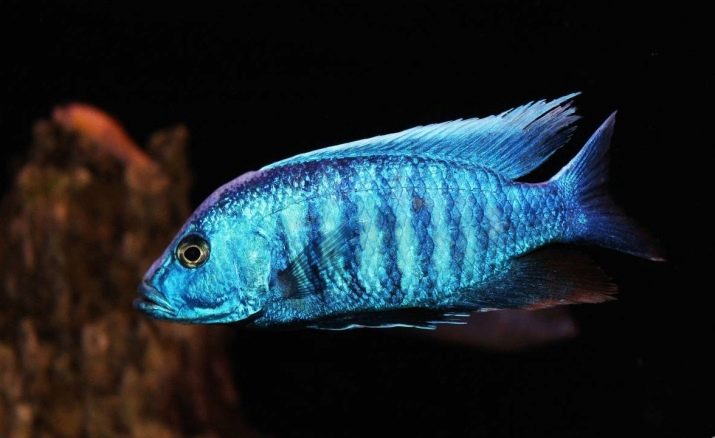
- Haplochromis philander because of the rather scattered habitats, it has several color options. The largest representatives (about 11 cm) have a yellowish-green color with a golden tint, but the back and sides have a light blue tint, the body is covered with blurry stripes, turning into spots in the tail. Fish with smaller sizes (8 cm) are distinguished by a yellowish-olive color (males) and a clay-yellow color (females). The fins have small greenish dots, and the male has a spot of bright red color near the anal fin.
Males of the smallest representatives of the philander from Southeast Africa (up to 8 cm) have the same color as their medium-sized relatives, only with a pronounced blue tint, the females are also similar.
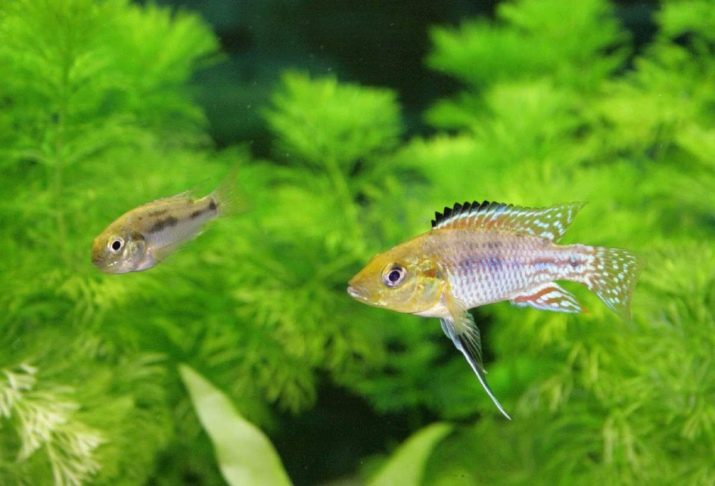
- Frontose - Inhabitant of the sandy bottom of Tanganyika. The body of the fish is long, with flattened sides and a high back, a characteristic growth appears on the head of adults. The body color of the frontoza can vary from grayish-white to gray-blue, on the sides there are six transverse stripes of different widths of a dark tone. This species of fish is distinguished by its phlegmatic nature and inactivity.
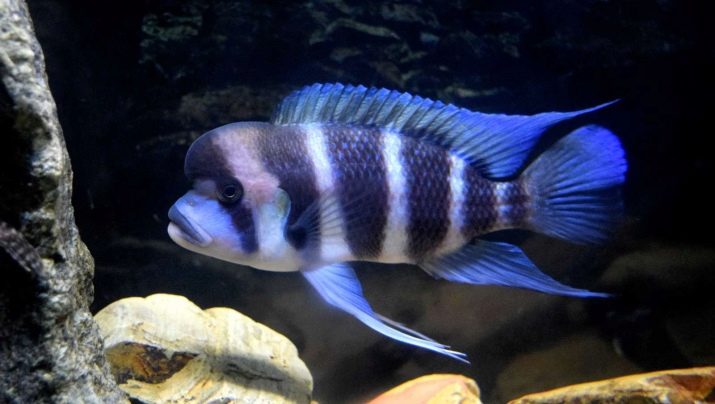
- Trophyus stellate is distinguished by a slightly elongated body, arcuate. The main color is black and blue, on the sides between the fins - the ventral and the beginning of the dorsal - there is a yellow, rather wide strip across. Dark-colored fins with black-blue edges and dots of a pale yellow hue. They can grow up to 12 cm.
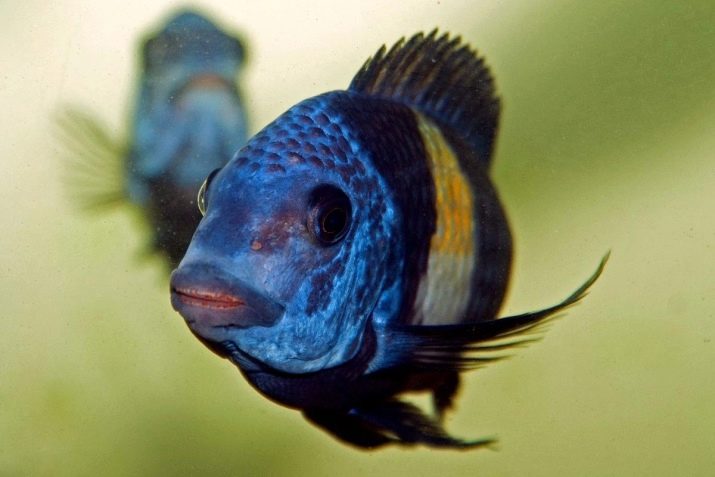
- Pseudotrophaeus pindani possesses an elongated body of pale blue color, sometimes with a slight purple tint. The fins have dark blue rays. On the anal fin of males are several yellow spots. Males are larger than females, but they have the same color.
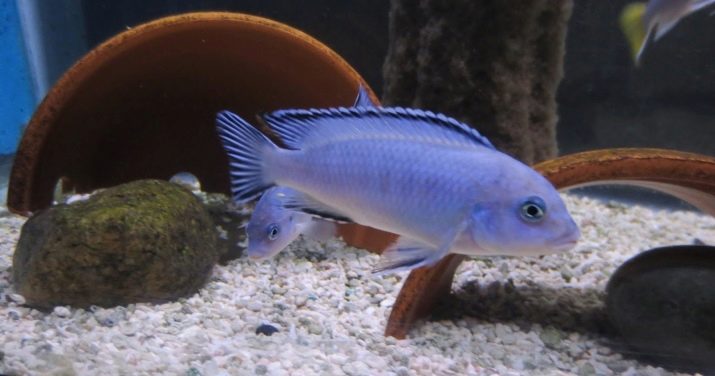
- Pseudotrophyus zebra different elongated, slightly compressed on the sides of the body and fatty formation on the head.The view is characterized by an extreme color palette - about 50 color options: white, blue, red, yellow, orange. On the sides are 7-9 transverse darker stripes.
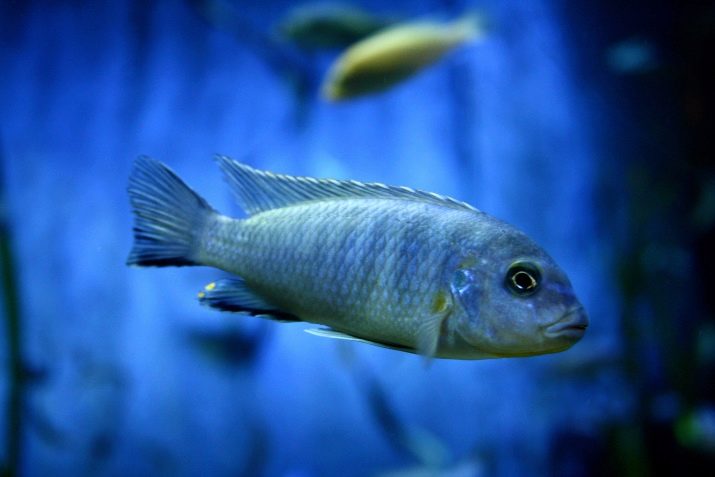
- Pseudotrophaeus Lombardo It has a yellow-golden or yellow-brown color, in some cases not very distinct stripes are visible on the sides. The fins are cast in a light blue tone, the anal is decorated with yellow dots, and the dorsal has a white border. The length of the fish reaches 15 cm.

- Lamprologus represented by several species, a characteristic feature common to all of them is an elongated body, the coloring is completely different. Lamprologologus blue has an elongated body of a bluish tone with five black stripes across the sides, a line of the same color is also located on the forehead. Because of its coloring, it was also called the five-lane zebra. The length of males is about 15 cm, females have smaller parameters.
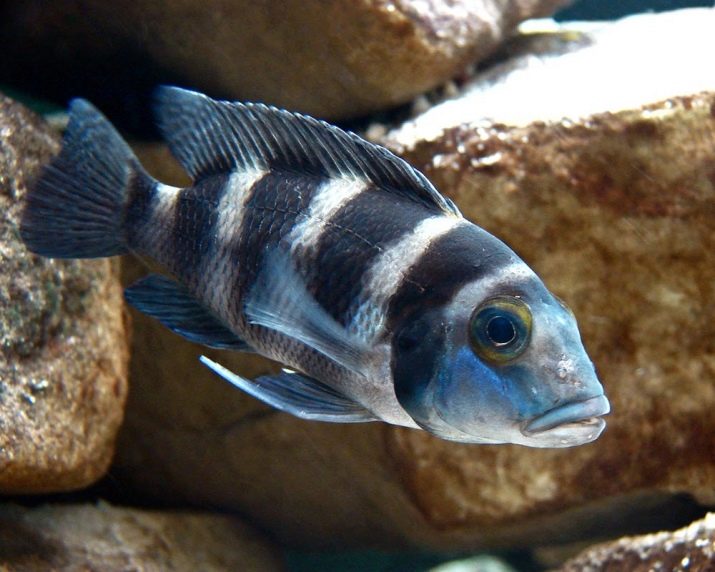
- Lamprologus ribbon seashell may have several colors: blue, brown, yellowish or creamy-orange; 9 thin silver stripes are located on the body.
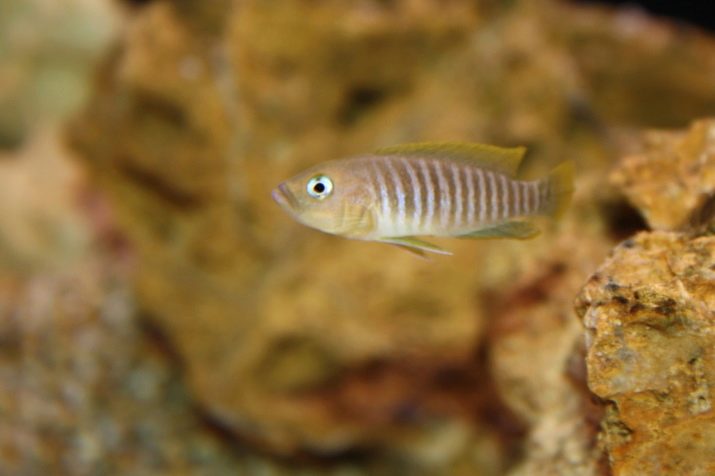
- Lamprologus orange differs in three color options: orange, golden yellow or blackish with numerous bright spots.
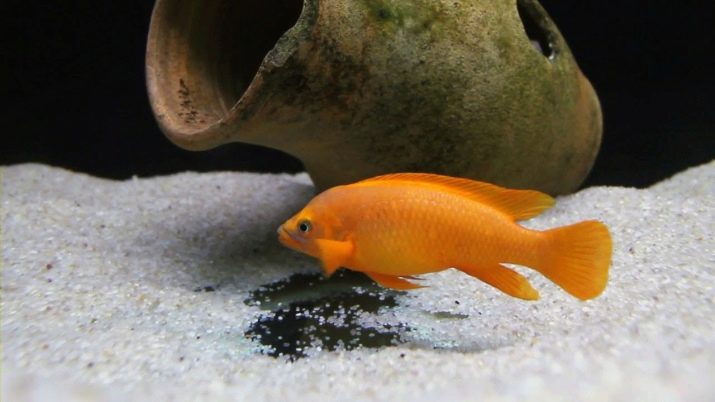
- Ophthalmic lamprologus has a light brown body, on which 3 rows of shiny scales are placed longitudinally.
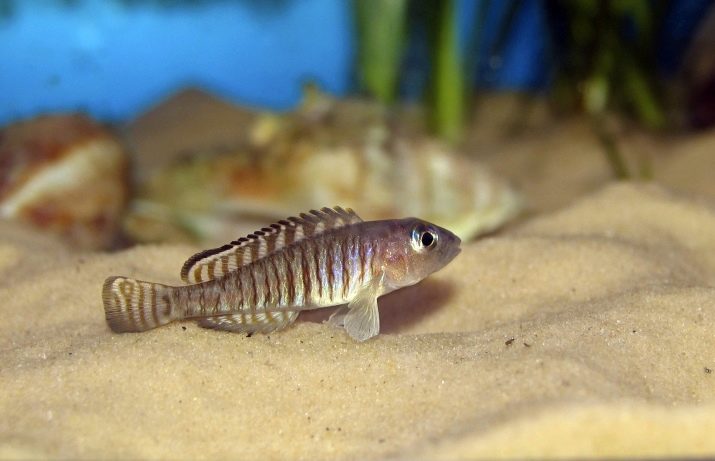
- Labidochromis yellow, also called lemon or hummingbird, belongs to the dwarf species of cichlids. Individuals of both sexes are yellow in color, in dominant males it is more saturated, and, in addition, their fins are black, the dorsal has a yellow border. Females have yellow fins.
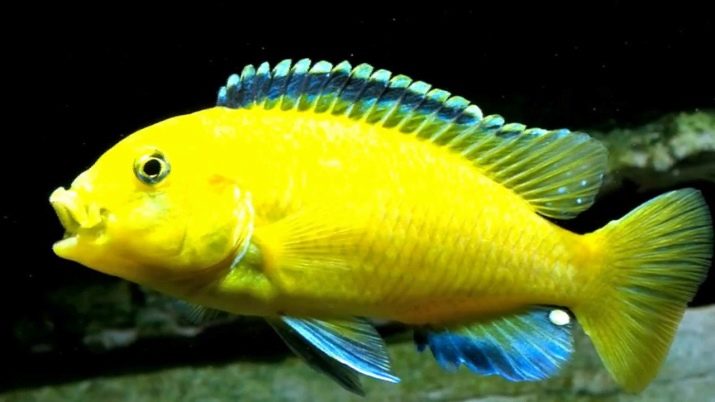
- Leopard golden has a flattened body and a high back. The main background is whitish yellow, the whole body is covered with large spots of olive-green color and black stripes. The dorsal fin has a golden edge and the caudal fin is yellowish-orange. When the male becomes sexually mature, his color changes completely, spots and stripes disappear, his head and belly become blue. The body becomes more yellow with slightly noticeable, blurry small spots.
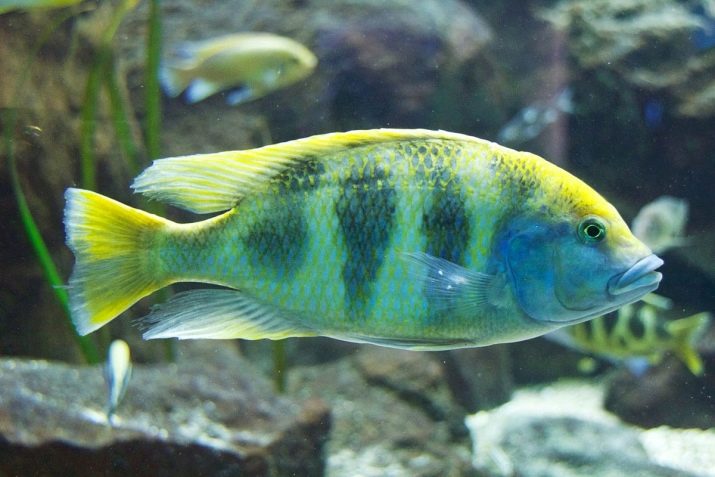
- Melanochromis Golden Auratus has different color options for individuals of different sexes. Males have a brownish-black body and a golden back, 2 blue horizontal stripes along the entire body parallel to the sides. The fins are white-yellow or blue; on the anal, there are 1-2 light dots.
The color of the females is golden yellow with brown stripes. The yellow fins also have brownish lines, and the tail fin is decorated with black spots.
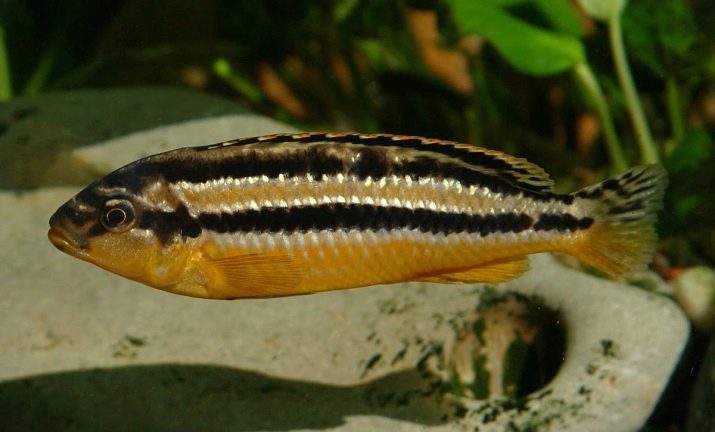
- Dolphin blue has a rather high, slightly densified body and a large head with a characteristic convex forehead (in adult males) and thick lips. Young dolphin representatives are characterized by a gray-blue color with a slight silvery sheen and dark stripes on the sides. In adult fish, the colors of the fins and body are velvety blue. During spawning, the bulge on the forehead of the male acquires a yellow color.
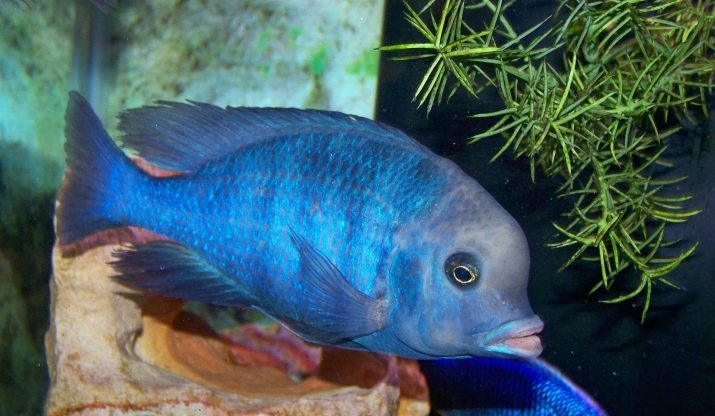
- Aulonocara Benshi characterized by a strongly flattened body of elongated shape. The male’s forehead and body are yellow, but the mouth, cheeks and gill are purple, 7-9 purple stripes are vertically located on the sides. The female has a dark brown color with 8-9 stripes of dark color. The length of the Aulonokara grow up to 12 cm.
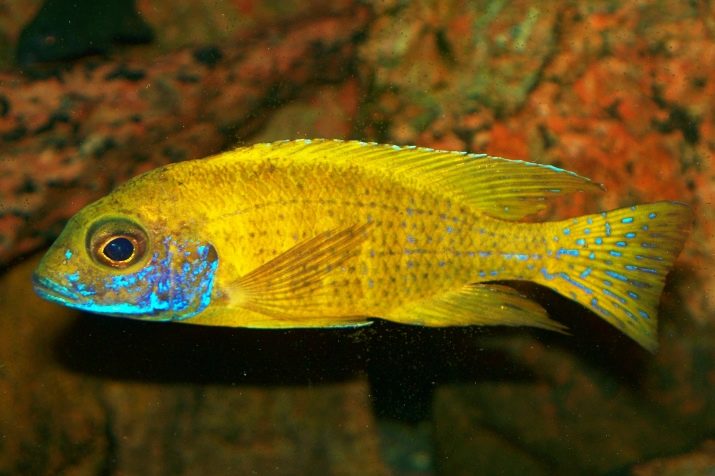
- Red cadango has a large head and mouth, which swallows large portions of water with plankton. In different parts of Lake Malawi there are several varieties of kadango that differ in color. Representatives of cadango with a bluish head and a yellowish or red body are popular as aquarium fish. Some fish have 3 black spots on both sides. Females are smaller and mostly grayish in color.

- Mayngano - also a dwarf species of cichlids with an elongated body and a rounded head. A low fin is located along the entire back.The color of the fish is dark blue with two stripes located horizontally and having a blue color. The edges of the fins and tail are bordered by a thin bluish strip.
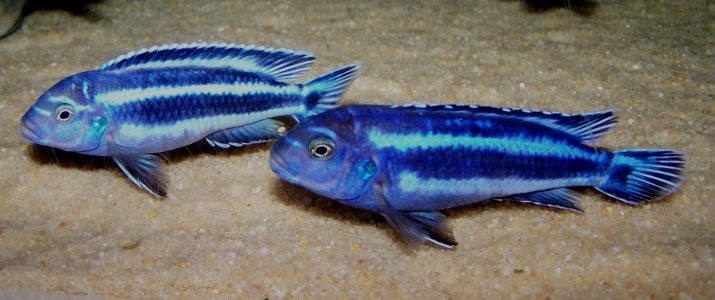
Cichlids of South America
This group of cichlids inhabits the Amazon and other rivers in the tropical and equatorial regions that flow into the Atlantic Ocean. In addition, many species live in different shallow reservoirs.
Unlike African cichlids, they have a less aggressive character and get along well with other fish in the aquarium.
- Angelfish differs in a rhomboid, compressed structure with long fins, pectorals are thin, filiform. Coloring can be varied.
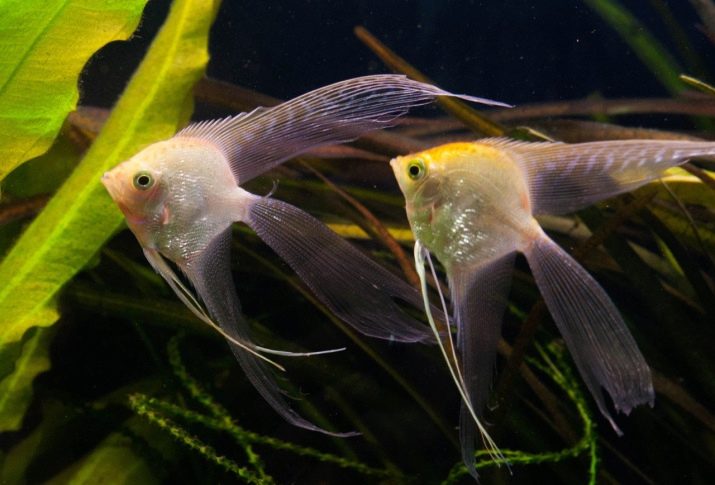
- Oscar - A rather large fish with a reddish-brick color and the presence of dark spots. The fins are rounded and dark in color.

- Severum Efasciatus It has an oval-shaped body compressed on the sides. The color of the fish is blue or bluish-gray, the males behind the head have a section colored in red. The dorsal and anal fins stretch along the entire body; in males, they have a more elongated shape and red color. Dark transverse stripes are located on the sides. The character of the fish is quite peaceful.
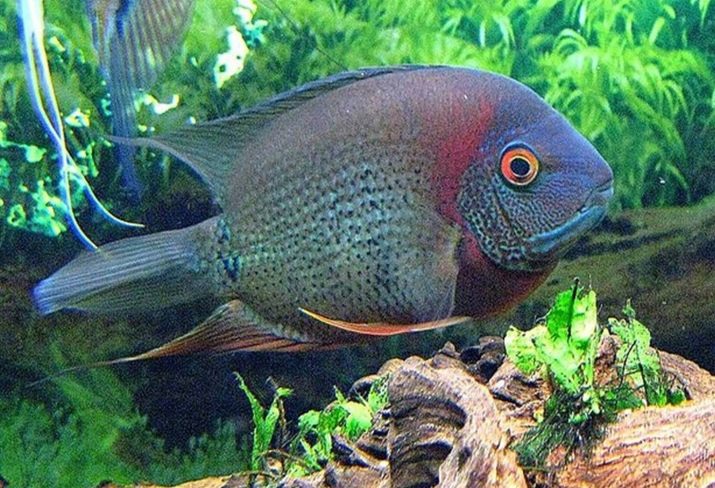
- Acara Blue or Blue not very large, adult fish are 13-15 cm in length. The color of the representatives of this species may be slightly different, but everyone is characterized by blue or blue gamma. Akara has a characteristic dark spot in the middle of the body and stripes in the direction of the eyes. Fins in males are pointed, while in females they are more rounded.
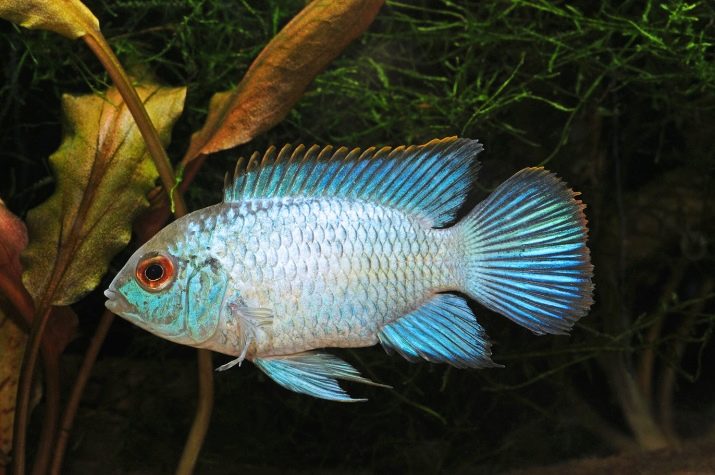
- Turquoise Akara has a color corresponding to the name, on each scale there is a black dot in the same way as on the fins. Males have fins larger than females, and a characteristic growth on the back of the head. The fins are decorated with orange bordering. The body also has a dark spot typical of all cancers.
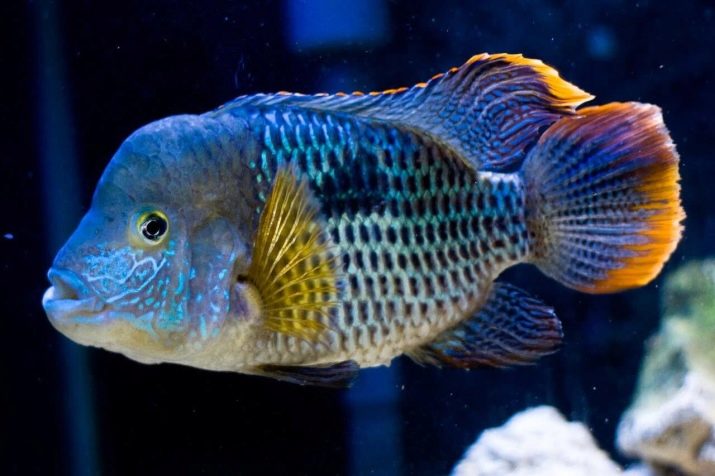
- Cichlid umbrella - a dwarf species, the length of the fish is only 5-6 cm. The color is blue or yellow-blue, in males the colors are much brighter than in females. The dorsal and anal fins are elongated. Fish are distinguished by a rather peaceful nature.
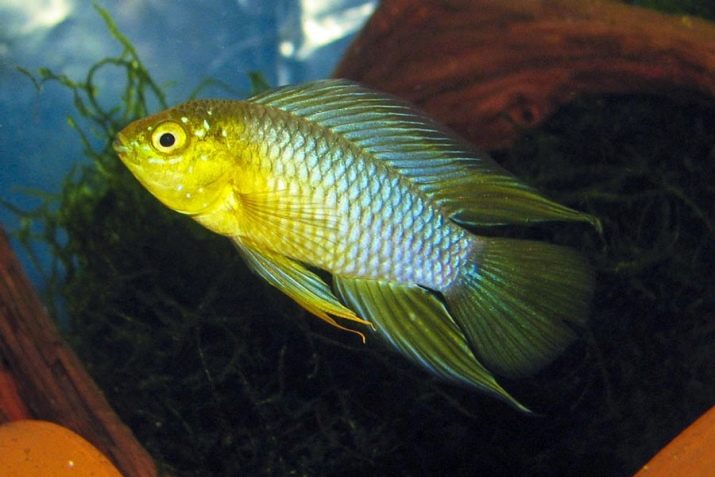
- Apistogram Agassica or cichlid Agassis also applies to small fish (5-7 cm), has a variety of colors, but yellow is considered the main color. A dark strip runs along the length of the whole body, the fins also have a darker border and patterns of dots of the same tone. Males have a brighter palette and elongated fins.
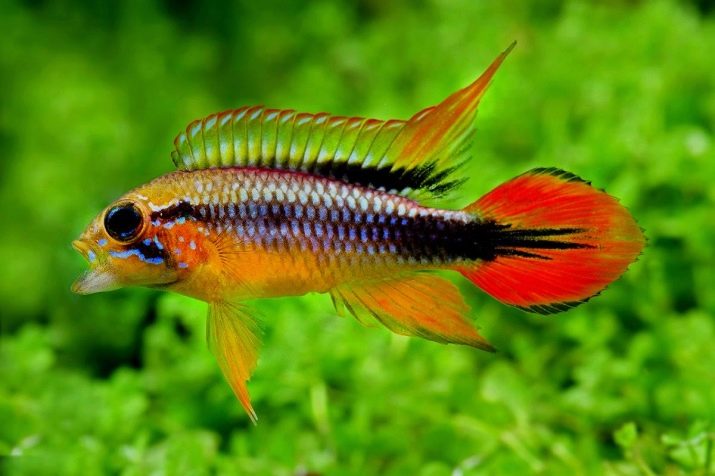
- Chromis handsome has an orange or red color with bright bluish dots throughout the body. During spawning, the color becomes much brighter. Males and females do not differ in color; on average, the length of the fish reaches 10-15 cm.
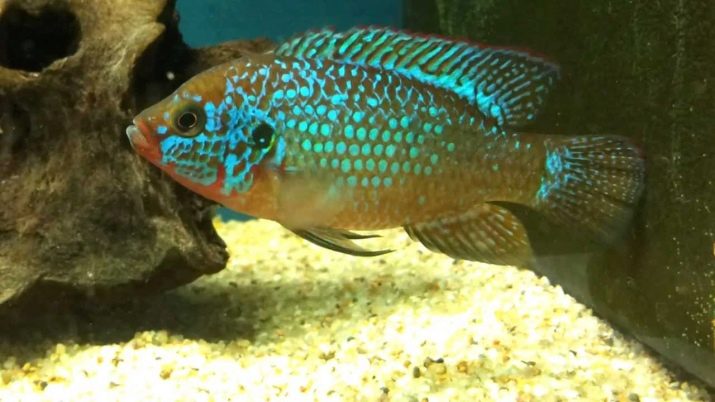
- Discus characterized by the presence of several species, which differ in color and various patterns on the scales. The body of the discus, strongly compressed on the sides, has a rounded shape. The dorsal and anal fins are located symmetrically, almost along the entire length of the body, but on the chest they are thin and elongated. The fish are quite large, about 25 cm in length.
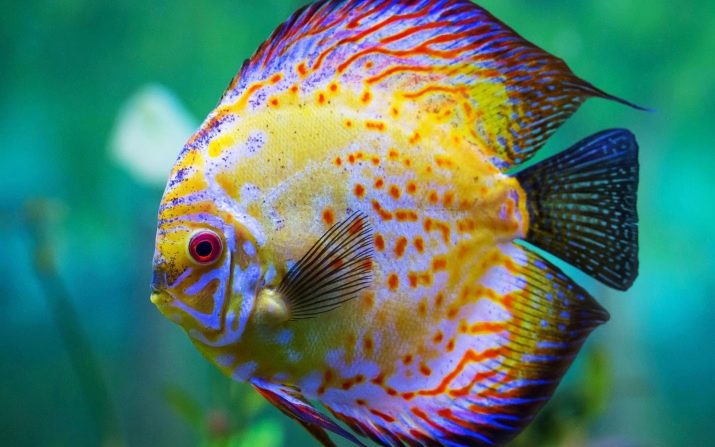
- Hongslo apistogram It stands out in a bright color, but the main colors are yellow and red. On the sides is a longitudinal dark or dark red strip. Males predominate in size, their length is 6 cm, and in females it is up to 4.5 cm. In addition, males differ in a much more saturated color palette.
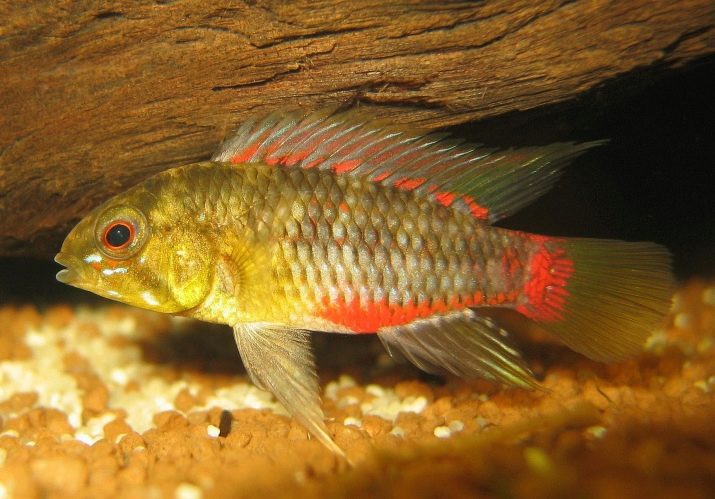
- Geophagus represented by several species, they got their names from the scientists who described these fish: the geophagus Steindahner, Weinmiller, Yurupar, Ipporang, Pellegrini. The color of the fish depends on the particular species, but they have in common the length, slightly elongated body shape and a characteristic growth on the forehead in males. Some species have longitudinal stripes on the sides or dots.
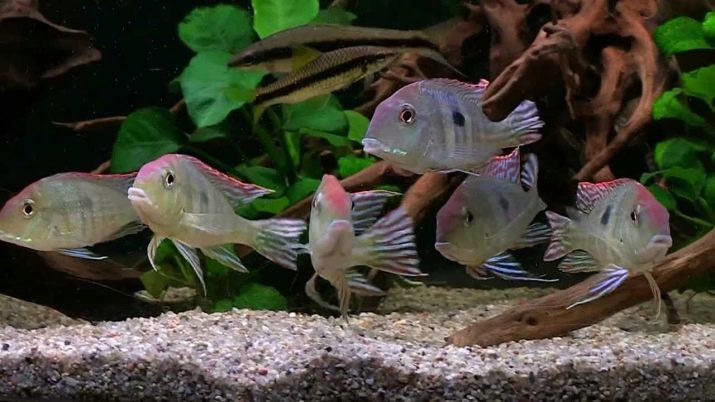
- Threaded Akara has a beige color with blue dots on the scales. Anal and ventral fins are bright, multi-colored, and dorsal and caudal fins are blue, with several long rays.Females are distinguished by large sizes, and males - by a brighter color.

- Cichlid Cupid does not differ in special sizes, reaches 10 cm. The front color is orange, and the back, back and fins are blue. Under the eyes there are spots of a turquoise hue, and a large dark one in the back. Individuals of different sexes do not differ much, but the general color may vary depending on the area of origin.
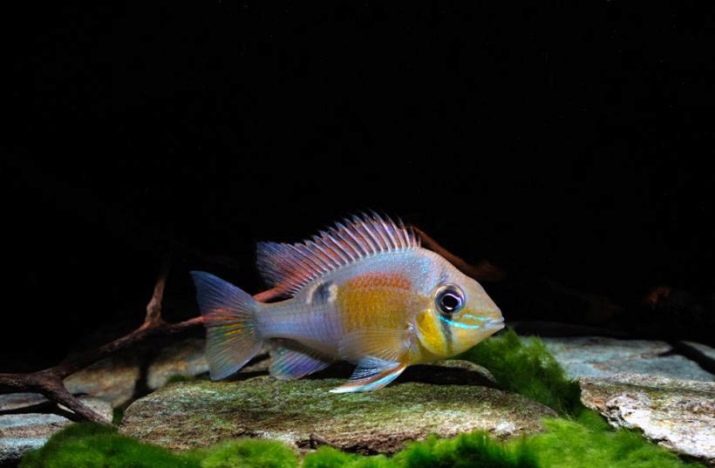
- Sedzhik Tsikhlazoma has a slightly elongated body, slightly flattened laterally. Males have a gray color with a brownish tint, the back is darker, and the belly and chest, on the contrary, are quite light, 7-9 transverse stripes are located on the sides. On the head there is a characteristic fat growth. The females are gray, with a brownish-turquoise tint. The fins have a black border, and the stripes are sharper than males.
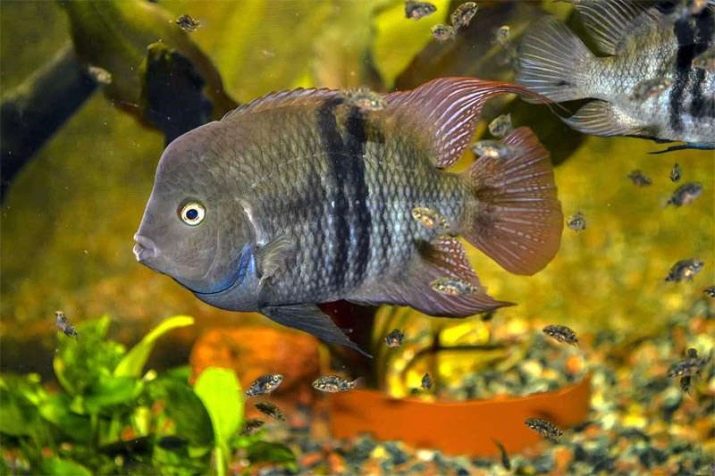
Other aquarium species
In addition to American and African cichlids, among hybrids, their hybrids bred in captivity are also popular.
- Flower horn with a reddish color and dark dots that create bizarre patterns on the body. Males have a rather large growth on the forehead, a saturated color and several long rays on the fins. Today, there are several species of this fish.
- Red parrot It has a rounded body with a small mouth that looks like a beak, which is why it got this name.
Coloring can vary from yellow and orange tones to red or scarlet, a solid color or with patterns of spots is also possible.


In addition, there are Asian cichlids, they are few in number, but despite this, they are also quite popular.
- Spotted Etroplus characterized by the absence of scales on the gill covers and head. The sides of the fish are yellowish tones, giving off a blue tint, the back is blue, brown or black, the belly is reddish-brown. Each flake has a red dot, and a black spot is located in the middle of the body. In addition, a number of dark spots are also placed on the sides. The length of fish rarely reaches 8 cm.
- Etroplus striped has a disc-shaped body of a greenish-brown color with darker transverse stripes on the sides and small dots covering the entire body.

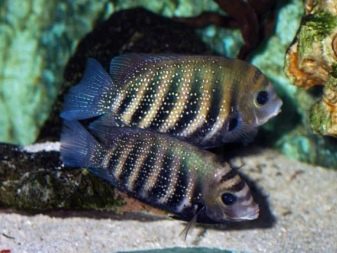
In addition to the described species, the family of cichlids is represented by many more worthy varieties, with no less beautiful appearance and popularity among aquarists.

You will learn about how to breed and care for the Blue Dolphin cichlids from the next video.
